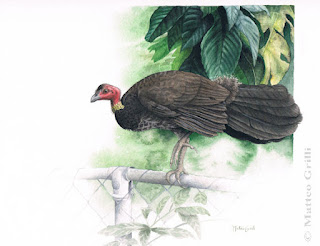 |
| A female Australian Brush-turkey on a backyard's fence. |
Stupid, ugly and invasive. These are the most common terms used to refer to this big, ground bird whose secret life has something truly remarkable. The male builds a nest, a mound that can be up to 4 meters across and 2m high, he gathers the material scratching ground litter and other organic matter with his large and powerful feet. Right in the middle of the mound, one or more females lay their eggs and leave them to the care of the father who will cover them with decomposing organic material to keep them warm. Checking the temperature of the nest with his beak, the male will scratch off some litter to cool it down or add some more to keep it warm and will also defend the area with great bravery from predators such as goannas and snakes.
The sex of the young depends on the temperature, just like crocodiles. After hatching, the chick finds his way up to the surface, and leave the nest on its own, completely able to provide for itself with no help from the parents, it is already able to fly and will roost on trees for the night just like the adults. Yes, they are destructive, whether they decide to build a nest or not in someone's backyard, when they scratch the ground for food they can destroy everything, seedlings, small plants, vegetables, and they dig out even sweet potatoes to eat the tuber. But they definitely thrive in many suburban or inhabited areas.
They showed to be able to adapt to the invasion of humans a couple of hundred years ago and to take the best advantage out of the new situation. For some, they're probably not as beautiful or regal as peacocks, but they certainly reveal a successful story of adaptability towards the change brought by the Europeans. The Australian Brush-turkey - Alectura lathami - .
An amazing insight book about the way Australian birds had to adapt to the harsh Australian environment, to the first human immigrations of the Aborigines and to the latest of the Europeans is Boom and Bust: http://www.csiro.au/Portals/Multimedia/CSIROpod/Book-and-Bust-book.aspx
Highly recommended.






